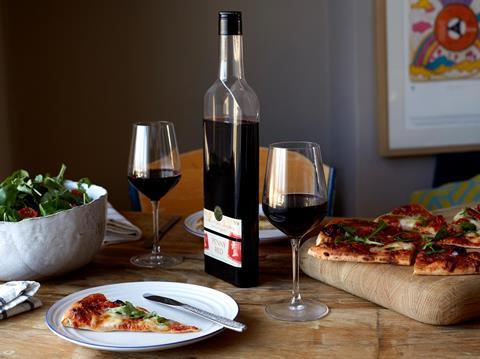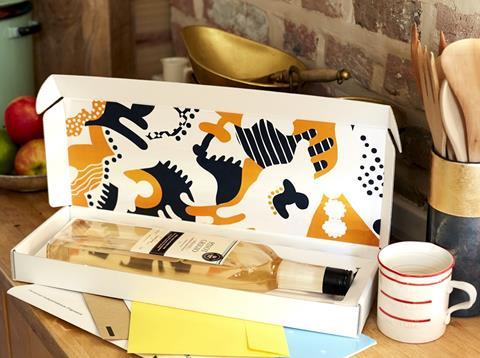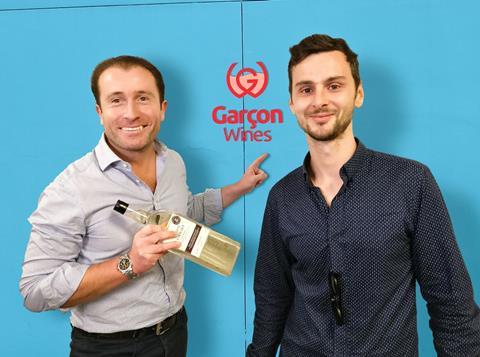
A story of how a simple change in deep-rooted packaging design can open a plethora of possibilities.
Santiago Navarro, co-founder of Garçon Wines alongside Joe Revell, shares the start-up’s fascinating journey of developing its ground breaking flat wine bottle with Packaging Europe’s Libby White. He explains how the solution has been propelled to international fame, and hints at grand ambitions to become the ‘Tetra Pak of wine’.
Starting with the clear aim to address a glaring problem – missed home deliveries of wine – Garçon Wines is now the winner of ‘best new beverage concept’ at the world beverage innovation awards 2017 with its first full-size postable wine bottles. It aims to revolutionise wine delivery and improve wine engagement, retailing & logistics.
Addressing a gap in the market
Joe Revell saw a clear millennial problem, the inefficiency of wine delivery to young urban drinkers in city centres. He approached Santiago Navarro, who has a strong background in wine retailing to help him bring a solution to market.
“We investigated different packaging concepts and the obvious solutions on the market that can be used to deliver wine effectively were bag-in-box or pouch designs,” says Mr Navarro. “I’m a traditionalist when it comes to wine and I love serving the bottle on the table, as I believe many consumers do also. Frankly the possible solutions we researched were not aesthetically pleasing in a social setting or on the dining room table.”
Arriving at a solution
“We came to our Eureka moment: why not take a round bottle and make it slimmer?”
The significance of serving wine in a traditional bottle was not lost on Mr Navarro. “We arrived at flattened concepts of the Bordeaux and Burgundy bottle designs,” he reveals. “These two shapes are well known across the world of wine, regardless of whether the content has originated in these regions.”
Initially, Garçon Wines struggled to prototype its designs. He explains: “The manufacturers that produce bottles of this shape at high speed and high volume were not ready or willing to help us as a start-up get off the ground. We were required to prove either that our product was in high demand, or to inject a large amount of investment into R&D.”
They had neither resource. “We had an idea on paper, shared only with a few close contacts and some industry specialists,” says Mr Navarro. The project went quiet.
The propellent
Garçon Wines then applied for the CNBC network TV series ‘Pop Up Start Up’, essentially winning the show and claiming a £20 000 cash prize. They subsequently worked with e-commerce giant Alibaba to create prototypes of their unique bottles – and brought the idea to life.
“We quickly grew from an idea to opening a pop-up shop in central London,” says Mr Navarro. “We received a great response from the public for our concept, showcasing the functional benefits alongside the aesthetical beauty of the product.
“Our product received an unexpected level of media coverage after the show, and as a result commercial enquiries.” Due to the increased interest, Garçon Wines looked beyond its initial ambition of establishing a B2C wine club, to set its sights on becoming a B2B wine packaging and wholesale business.
Today, Garçon has protected its intellectual property in 35 countries for several designs of the world’s first full-size postable wine bottles, and is extending its packaging and wholesale business internationally. It is also breaking new ground by supplying multi-packs for shops that are easier for retailers to store and consumers to carry home.
Expanding scope
Packaging a standard 750ml of wine, the bottles come in post-box friendly packages. The slimline solution is not only convenient and effective for home delivery, it has the scope for adding value in other scenarios such as on cruise liners, ferries, trains, planes, and at festivals. Possibilities have also expanded from wine into other alcoholic beverages.

Mr Navarro comments, “There is a growth in interest across the alcoholic beverage industry for direct to consumer supplies. Brands see the huge potential in engaging directly with consumers, and maintaining direct relationships. We see this as more established in the US market; the European market has more complexities throughout the supply chain which makes this a harder task.”
He underlines that with their solution, home delivery makes sense not only for the wine industry, but also for other high value to volume liquids. He adds, “We have also had an enquiry from one of the biggest producers of olive oil in Spain. Naturally, we have the scope to extend into other markets, which we hope to address in the future.”
Packaging development
Garçon Wines points to the environmental impact of lightweighting as an additional benefit of the format. Conventional glass wine bottles fall between 500-550 grams in weight, whereas the Garçon Wines bottle is 60 grams. For logistics and storage, the bottles save 34 per cent in space versus a round bottle as they easily slot in next to each other. “This translates to a massive reduction in carbon emissions logistically and throughout the supply chain,” Mr Navarro is proud to point out.
He emphasises that as an environmentally conscious company they have opted for post-consumer recycled PET: “We are seeing a lot of innovation in plastic with regards to sustainability. Coca-Cola for example has been an influential push in the green direction. Our goal is to enter the market with 100 per cent post-consumer recycled PET in both clear and colour bottles.
“Our solution will be produced by a world class manufacturer using world class technology so the resulting bottle will be of a high quality appearance. You will need to touch it to ascertain whether it is glass or plastic.”
Garçon has retained the services of a packaging specialist, Sarah Greenwood, who has advised on the barrier technologies needed to ensure the packaging minimises oxygen ingress through an active barrier and maximises the shelf life to 12-18 months.
The bottles will have traditional labels on the front and back, as commonly seen in the industry. Taking into consideration how consumers choose wine, Garçon offers two levels of labels for standard and premium grades of wine, using existing knowledge and research to create wine labels that are helpful for the consumer.

Complementing the conventional
“We have had a superb response from the wine industry,” shares Mr Navarro, “and we were pleased to see this summer that there has been a big uplift in the use of bag-in-box in the wine industry. Cork to screwcap is another great example of acceptance. It took a while to catch on and now both solutions exist together in harmony. There is a time and a place for both designs. Consumers are ready to embrace innovative packaging and I think the industry has realised that things need to change.
“I believe in our case the wine industry has been accepting as we respect the traditional shape of the wine bottle. It has such a long heritage and consumers immediately engage with it.”
More info:










